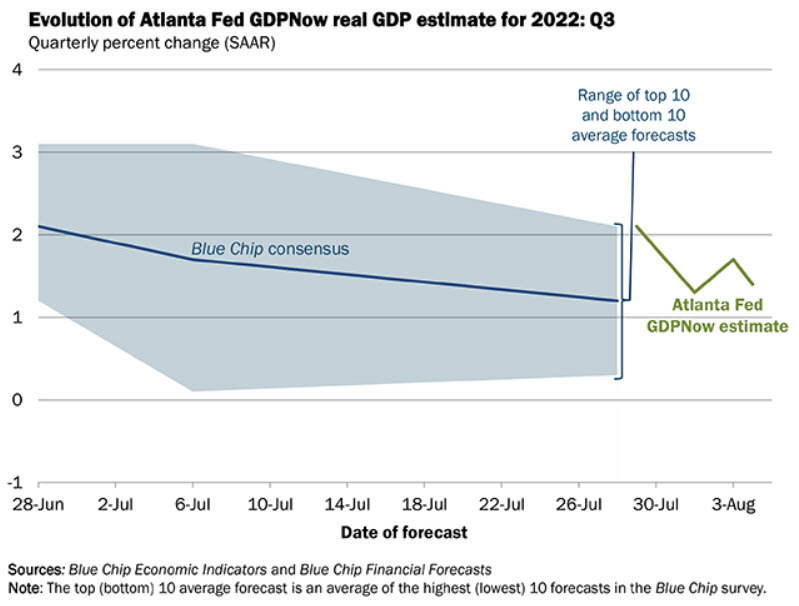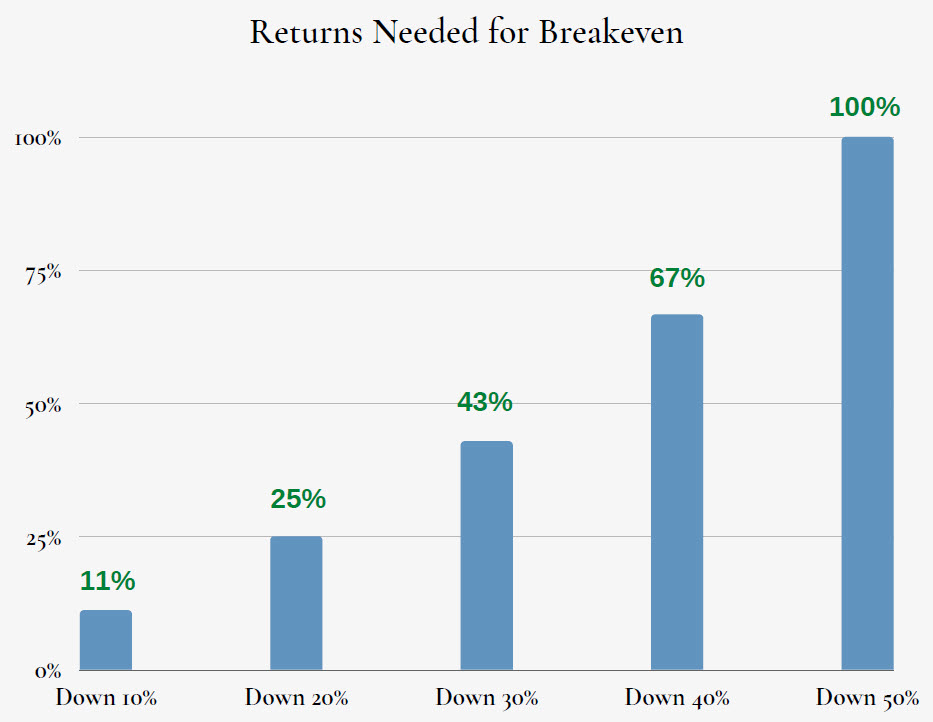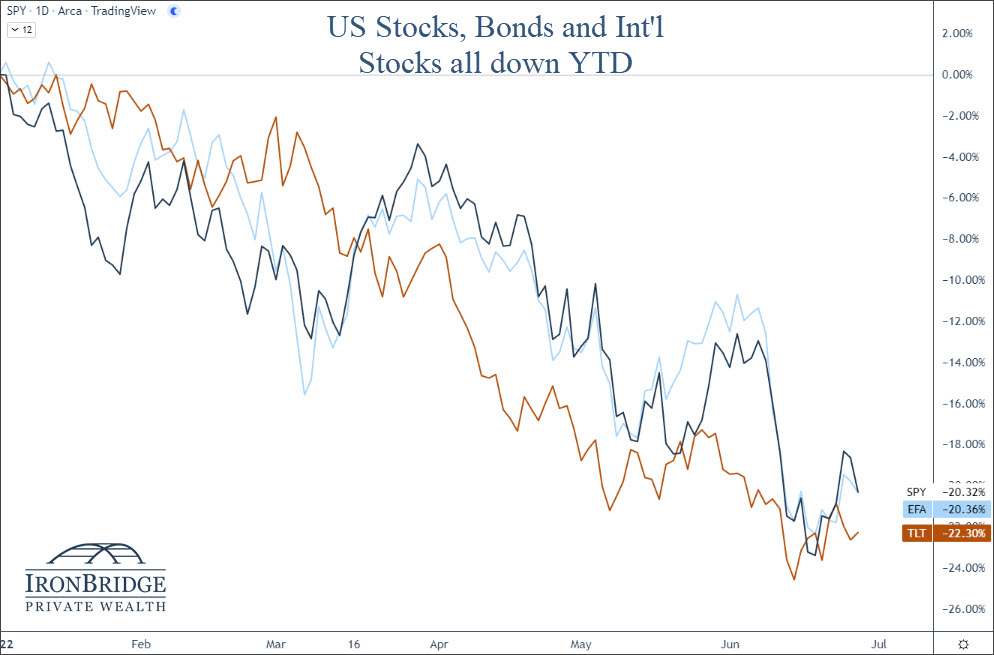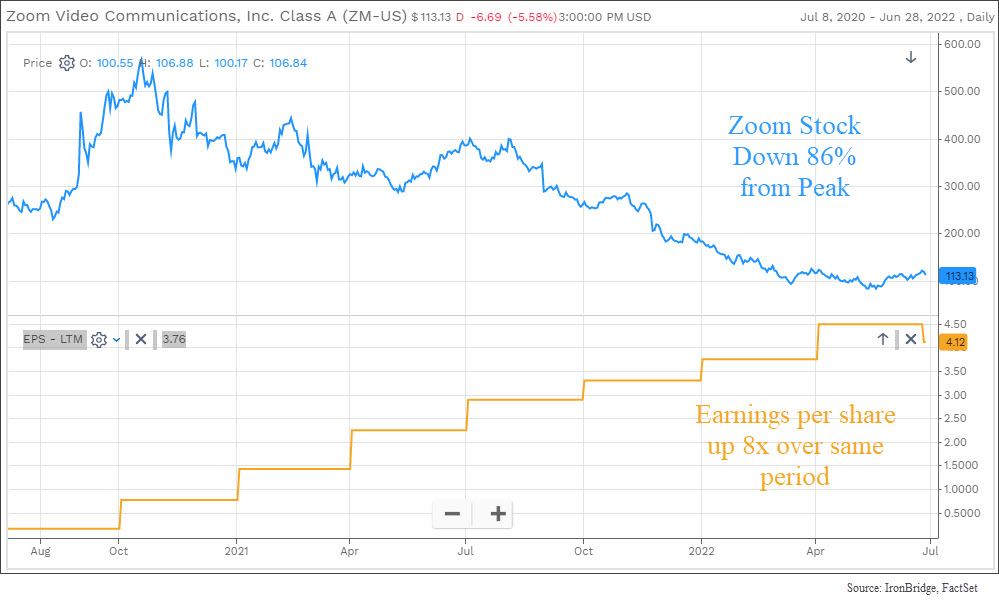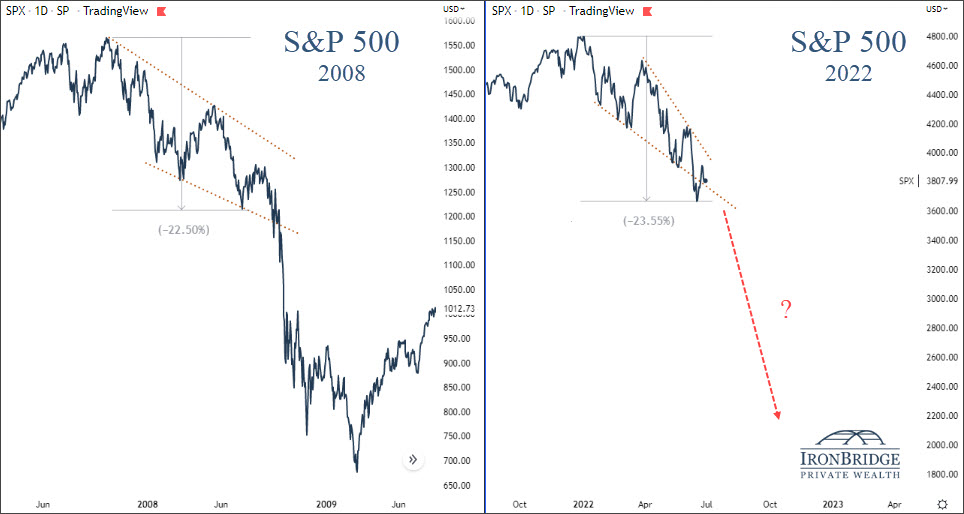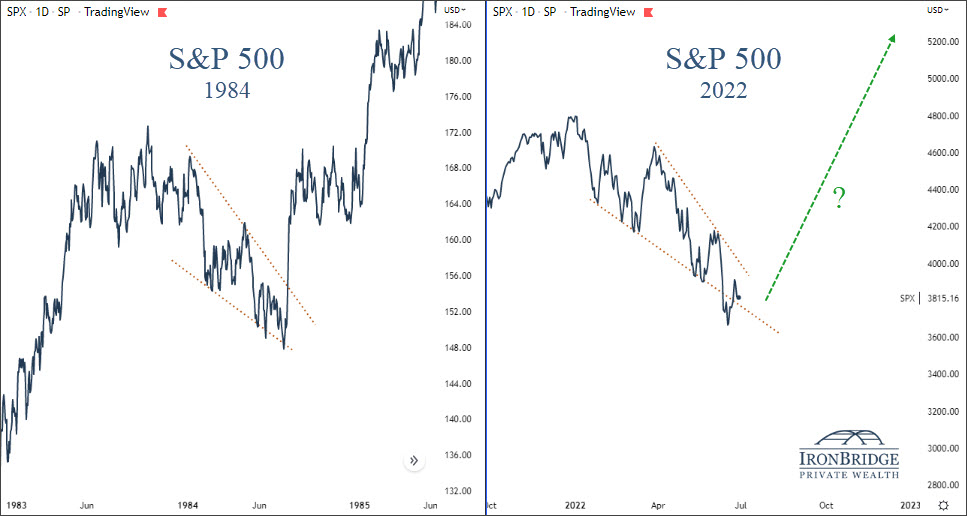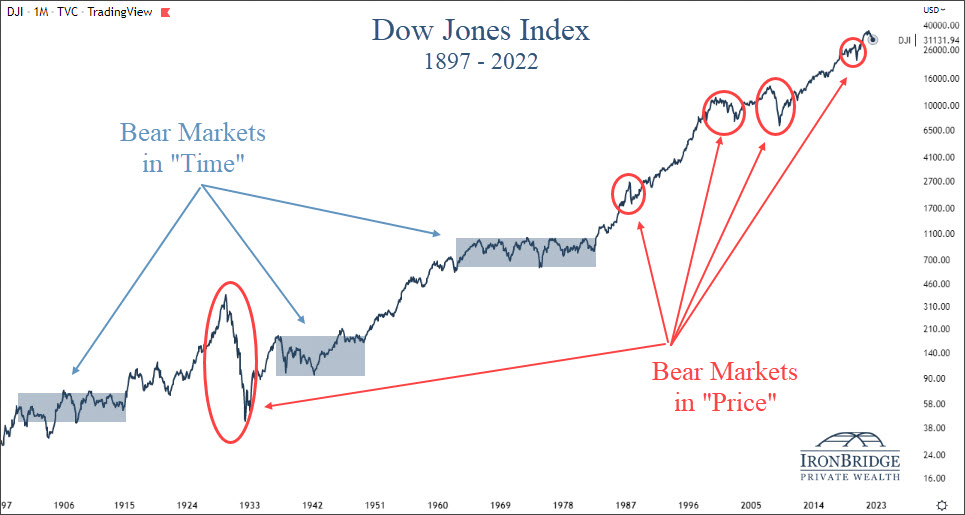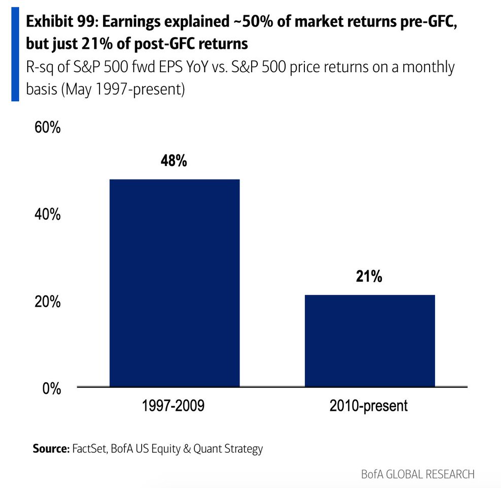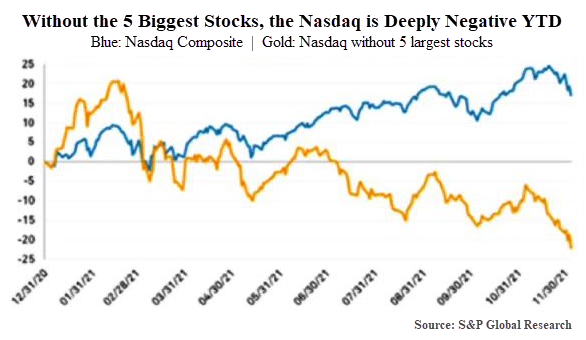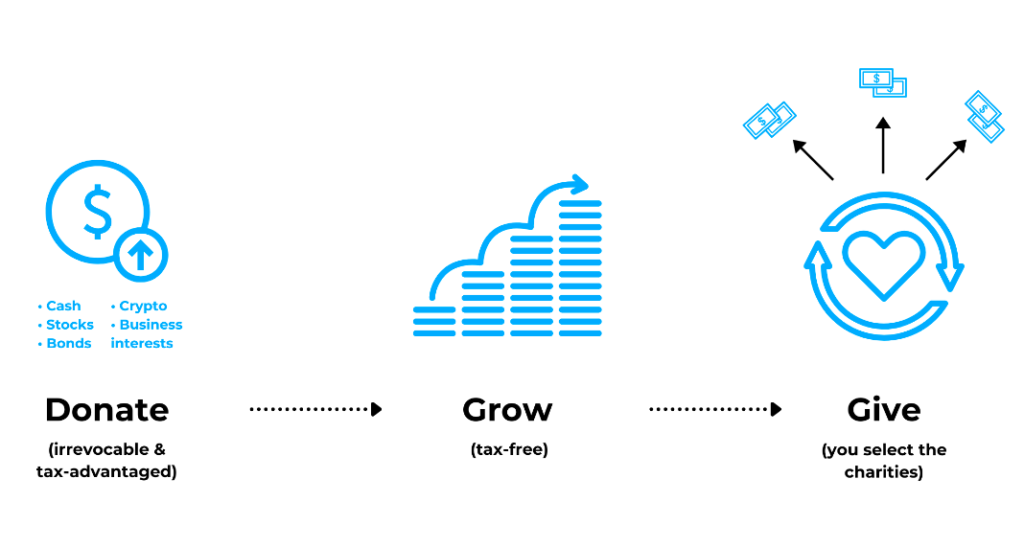
“To be or not to be–that is the question: Whether ’tis nobler in the mind to suffer the slings and arrows of outrageous fortune or to take arms against a sea of trouble and by opposing end them.”
hamlet, act 3, scene 1
July was a nice month in the markets.
Which begs the question…have we seen the lows in this bear market?
Should we expect markets to continue to rise and suffer the slings and arrows of outrageous fortune? Or is this yet another fake-out like we’ve seen twice already this year and we go back into a sea of trouble?
The answer? It depends.
In most environments, it “depends” on a complex series of data points could shape the direction of the markets.
However, today’s environment seems more simple on the surface.
It depends primarily on only one variable: whether we are in a recession or not.
The reason is very simple…markets respond differently to pullbacks similar to what we’ve seen this year based solely on if it happens during a recession or not.
Let’s look at some historical context.
S&P 500 Performance: Recession vs No Recession
Markets can decline without the economy being in a recession. Since 2009, we’ve seen this happen a few different times:
- 2011: US Debt Downgrade
- 2016: Chinese Yuan Devaluation and Oil Crash
- 2018: Random 20% decline in the 4th quarter
Each of these times, markets fell roughly 20%.
And each of these times, markets recovered losses within 18-24 months.
But there was no recession during these periods.
Our first chart below, courtesy of Ned Davis Research, shows this dynamic. The chart shows declines of at least 18% and separates it between two categories: whether it occurred during a recession or not.

The black line is the performance of the S&P 500 when there was no recession, while the blue dotted line shows the performance if there was an official recession.
We are currently two months past the recent lows, as indicated by the red dashed line.
Based on what the market has done historically, the results are very clear: if we’re not in a recession, we should expect the next 12 months to be pretty good. If we are in a recession, we should expect more volatility and a retest of the lows.
Which begs the question…are we in a recession or not?
Are We in a Recession?
Normally, determining a recession is pretty straight-forward: it is two consecutive quarters of negative GDP growth.
Both Q1 and Q2 this year were negative.
So by historical definitions, yes, we are in a recession.
But it may not be quite that simple this time.
We don’t like to get political in these reports, because the world focuses way too much on the self-absorbed, sociopathic political class.
But with mid-term elections around the corner, the incumbents are trying to change the definition of a recession.
It’s an overly transparent pre-election tactic. But we will reluctantly admit that in this case, they may have a point.
(To be fair to our politician friends, many economists agree that the first quarter did not resemble a typical economic recession.)
Let’s look at the data.
The first quarter GDP came in at a negative 1.4%, mostly because of two things:
- Defense spending fell 8.5%
- A trade imbalance due to a strengthening US dollar resulted in a negative 3.2% from total GDP.
Remove these two factors, and GDP is positive. In fact, if you simply remove the trade imbalance, GDP is positive.
Economic data in the first quarter was fairly positive as well, led by consumer spending, which was up 2.7%.
While the first quarter showed relatively good economic data, the second quarter was recessionary without question.
Second quarter GDP was negative 0.9%. And the negativity was more widespread.
- Inventory investment decreased 2.0%
- Housing investments decreased 0.7%
- Federal and State spending both decreased slightly
- Business investment decreased 0.1%
- Consumer spending rose by a more moderate 0.7% (down from 2.7% in Q1)
With the underlying strength in the first quarter, it’s not out of bounds to assume that we’ve only seen one quarter of truly negative GDP growth.
(For the record, we don’t think we should change the traditional definition of a recession, but we should always put GDP data in context, both positive and negative.)
Which makes the current quarter especially important.
If we have negative GDP this quarter, there is no question that we are in a recession. The question then becomes how bad it is and how long it lasts.
Atlanta Fed GDPNow
One way to keep track of current GDP estimates is through the Atlanta Fed’s “GDPNow” tracker. (You can view the site HERE.)
As of Thursday, August 4th, they are projecting a 1.4% GDP for Q3, as shown in the next chart.
Granted, the estimate has steadily declined since the start of the quarter, and we still have almost 2/3 of the quarter left. So anything can happen.
And this data is also based on human estimates, which can be skewed.
But it should at least give us some hope that maybe we don’t see a formal recession this year. And if we do see one, it would likely be fairly mild.
This morning’s jobs report adds to the hope that we may not be in a recession just yet. The economy added 528,000 new jobs this quarter, and as of July has officially recovered the number of jobs lost during COVID.
However, we shouldn’t get too complacent at this point.
While GDPNow is showing positive estimates for current GDP, there are huge warning signs right now that should give us cause for concern.
Inverted Yield Curve
Historically, one of the best recession indicators has been an inverted yield curve. This occurs when the 10-year yield on US Treasuries are LOWER than the 2-year yields.
The next chart, courtesy of Bloomberg, shows this inversion.
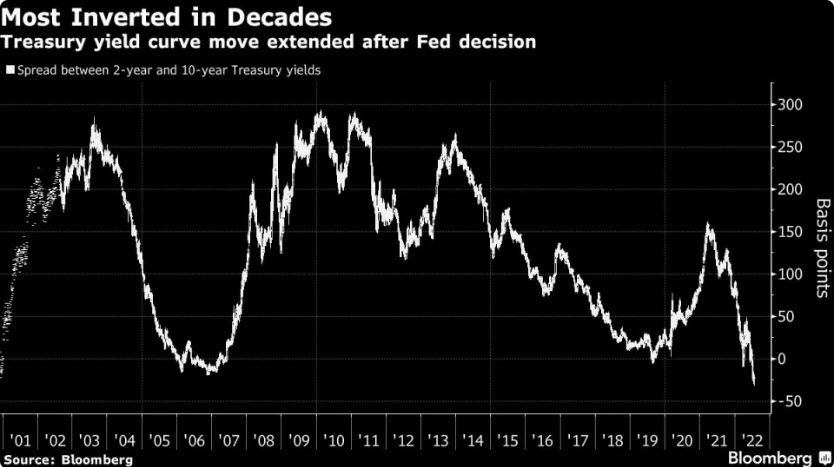
When the line goes below zero, the curve is inverted.
Right now, it is more inverted than at any time since Paul Volker started fighting inflation the early 1980’s.
It is more negative than COVID, than the global financial crisis, the tech bubble, and various recessions during the 80’s and 90’s.
We strongly believe that it is imprudent to ignore this data point.
But this data point isn’t a very good timing indicator of when a recession may happen.
In reality, it is when the curve starts to steepen AFTER it has been inverted that is a better indicator that a recession is imminent, and we haven’t seen that happen yet.
Housing Market Concerns
While the inverted yield curve is a bit more theoretical in nature, there are real economic data points that are showing signs of stress.
The housing market plays a huge part in economic activity, accounting for 15-18% of US economic activity on average.
Leading indicators in the housing market are showing reason to be concerned.
One of these is cancellation rates, as shown in the next chart from Redfin.
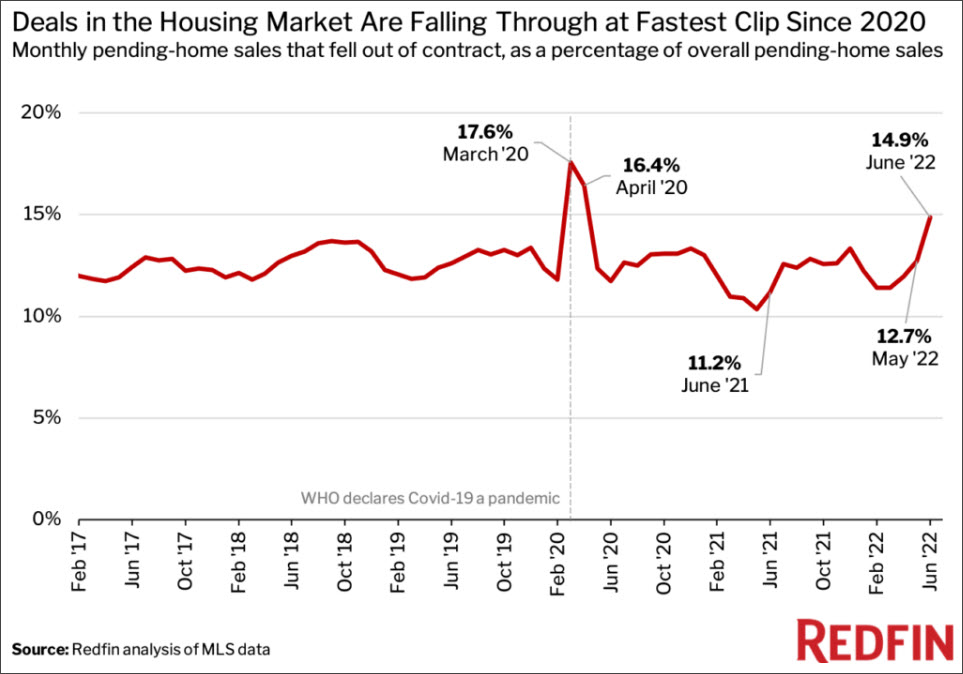
Cancellations happen when an accepted offer is withdrawn by either party.
In this case, the majority of cancellations are due to buyers backing out.
There are legitimate reasons for this happening:
- Mortgage rates have increased, making it unaffordable for a buyer to proceed;
- Property taxes have been reassessed higher, increasing the cost of housing;
- People anticipating that prices may fall, causing buyers to withdraw offers.
Here’s a link to the article discussing cancellations:
Another reason for cancellations is a drop in consumer confidence, which has a big effect on economic conditions in the US.
Consumer Confidence
While the housing market is a large part of the economy, the consumer as a whole is much more important. Approximately 70% of the US economy is driven by the consumer in one way or another (this includes housing).
So when consumer confidence slows, economic activity typically slows along with it.
And the consumer is in the dumps right now, as shown in our next chart.
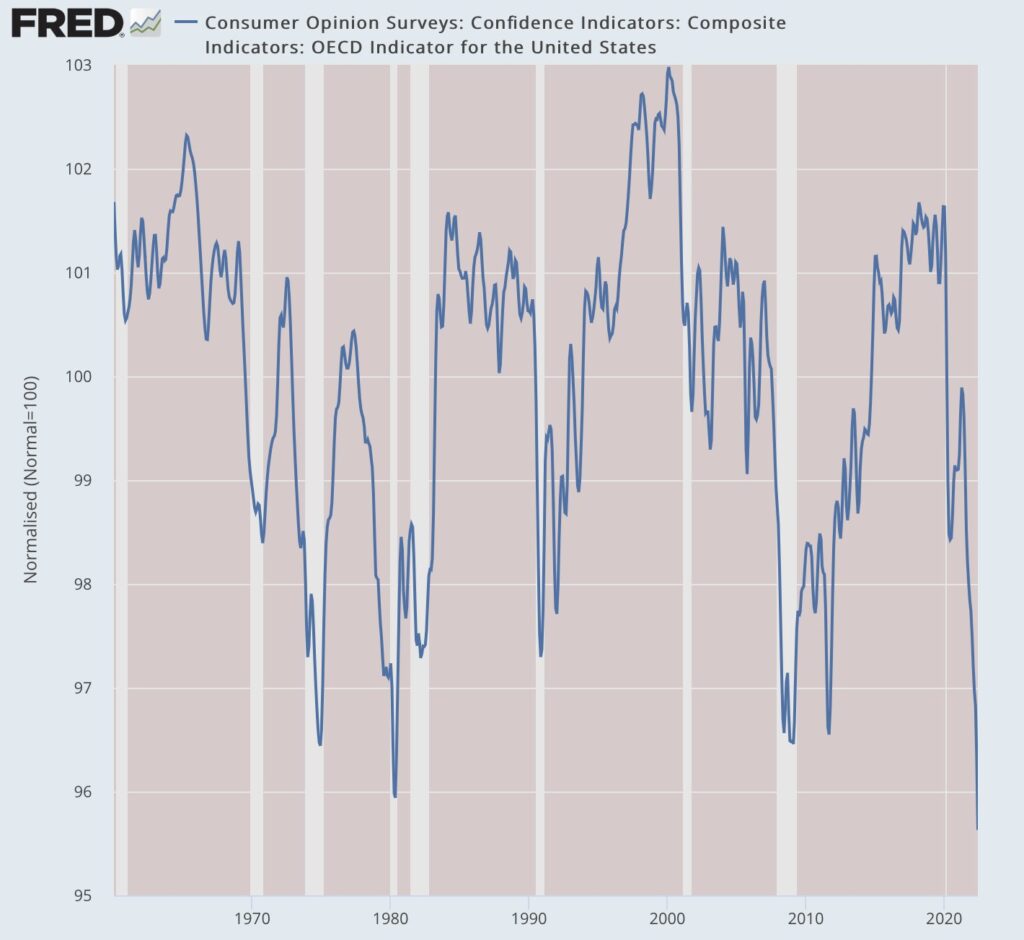
Right now, the consumer is the least confident they have been at any time in the past 60 years. This includes the Vietnam era, the inflation of the 1970’s, the tech crash, the global financial crisis, and COVID.
That is concerning.
But what does all of this tell us about the near-term direction of the market?
S&P 500 Index
All of the data listed above is not news to the market.
Despite these concerning data points, markets have rallied over the past seven weeks.
But the move higher since June looks almost identical to the one in March, as shown in the chart below.
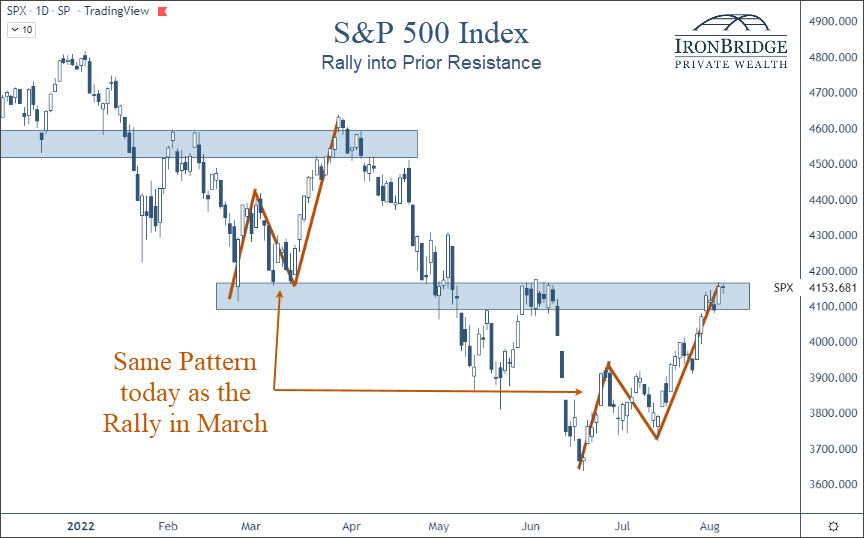
Specifically, the pattern is a three-leg move higher into previous highs.
There was an initial leg higher, a move lower of roughly the same timeframe, then an extended move higher in both time and price.
The move in March followed the Ukraine invasion.
The move in June really didn’t have any catalyst, other than the overall market being incredibly pessimistic.
In addition to the S&P 500, nearly every major US stock index looks identical.
The next chart shows the S&P 500, the Russell 2000 small cap index, the Nasdaq Composite and the S&P Mid Cap index.
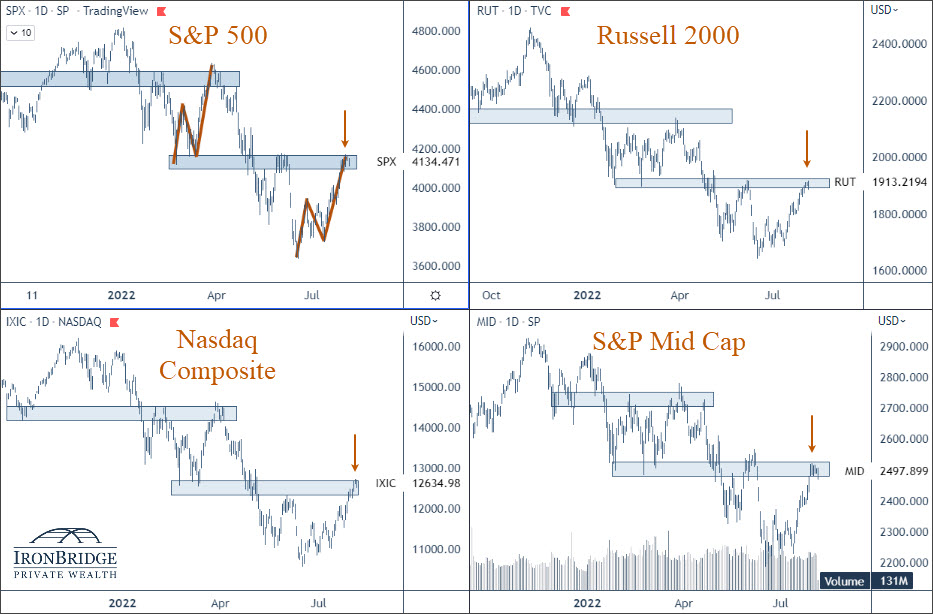
Every one of these indices are at the same resistance level. This means that the market thinks these levels are important.
Regardless of the reason for the move in June, it has been strong. Earnings reports have been more positive than expected, and the market is starting to predict that the Fed will become more accommodative and “pivot” by slowing the rise of interest rates.
If the market is going to do it’s own pivot and head back lower, it must do so very quickly.
If it breaks above this resistance area, then we can begin increasing equity exposure in client portfolios, at least for a period of time.
If it heads lower, then we should expect a fairly quick move to test the lows from June.
Bottom Line
While a big consideration for the market is the current recession debate, markets are extremely complex systems. Relying on only one data point for decision-making would be foolish.
When looking at a variety of data points, it truly is a mixed bag out right now.
Recent market strength and earnings reports have been mostly positive. As such, the market seems to believe the Fed will slow down the pace of interest rate increases. (Frankly, this expectation seems to be unwarranted, especially after today’s employment numbers.)
For now, the move higher over the summer appears to be a typical bear market rally. As such, we have been intentionally slow to add equity exposure.
Why?
Mainly because there is still plenty of upside if the market wants to keep pushing higher. For example, the Nasdaq is down nearly 23% this year, even after a big rally over the summer.
And big stocks like Google, Microsoft, Facebook and Netflix still have massive upside potential at current levels.
If the market can get above the levels noted in the S&P chart above, there starts to be more proof that this rally may be more than just another temporary rally.
But if we do go into a recession, all bets are off. And there are many indications to suggest we are headed in that direction.
Bottom line is that we believe it is prudent to underweight risk right now, given the massive uncertainties in the market and the economy.
Invest wisely!

